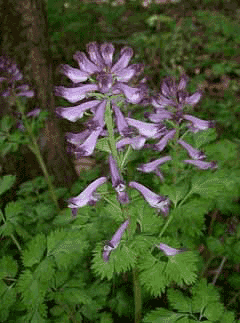 |
|
http://commons.wikimedia.org/wiki/User:KENPEI |
 |
| http://commons.wikimedia.org/wiki/User:KENPEI |
Translate this page:
Summary
Physical Characteristics

 Corydalis incisa is a ANNUAL/BIENNIAL growing to 0.3 m (1ft).
Corydalis incisa is a ANNUAL/BIENNIAL growing to 0.3 m (1ft).
See above for USDA hardiness. It is hardy to UK zone 7. The species is hermaphrodite (has both male and female organs) and is pollinated by Bees.
Suitable for: light (sandy) and medium (loamy) soils and prefers well-drained soil. Suitable pH: mildly acid, neutral and basic (mildly alkaline) soils. It can grow in semi-shade (light woodland). It prefers moist soil.
UK Hardiness Map
US Hardiness Map
Synonyms
Fumaria incisa Thunb. (NGRP, 2017), Capnoides incisa Kuntze (The Plant List, 2017). The Plant List (2017) lists additional synonyms at the infraspecific level.
Plant Habitats
Woodland Garden Dappled Shade; Shady Edge;
Edible Uses
Edible Parts: Leaves
Edible Uses:
Young plant - cooked in spring[177, 178, 179]. Slightly deleterious[178].
References More on Edible Uses
Medicinal Uses
Plants For A Future can not take any responsibility for any adverse effects from the use of plants. Always seek advice from a professional before using a plant medicinally.
Miscellany
The dried and powdered flowers are used in the treatment of rectal collapse[218]. An aqueous decoction of the plant is used in the treatment of abscesses[218]. Used in China and Japan in folk medicine to treat inflammation, headaches, skin
diseases, and other ailments [1-7].
References More on Medicinal Uses
The Bookshop: Edible Plant Books
Our Latest books on Perennial Plants For Food Forests and Permaculture Gardens in paperback or digital formats.

Edible Tropical Plants
Food Forest Plants for Hotter Conditions: 250+ Plants For Tropical Food Forests & Permaculture Gardens.
More

Edible Temperate Plants
Plants for Your Food Forest: 500 Plants for Temperate Food Forests & Permaculture Gardens.
More

More Books
PFAF have eight books available in paperback and digital formats. Browse the shop for more information.
Shop Now
Other Uses
References More on Other Uses
Cultivation details
Can be invasive outside its natural range. Corydalis incisa is an annual or biennial, spring-ephemeral herb. Seeds germinate in the spring and develop small rosettes, which wither during the summer. They emerge again as rosettes throughout the winter and produce compact flowering racemes the following spring [1-7]. In its native range in Asia, C. incisa occurs along stream valleys, irrigation channels, and forest margins; in wastelands, roadsides, and forestlands; and on rock walls. In the United States, it grows in mesic and alluvial forest habitats. Under horticultural conditions, C. incisa prefers cooler exposures [1-7]. The known distribution globally has Plant Hardiness Zones 6-10, areas with 20-100+ inches of annual precipitation, and the following Köppen-Geiger climate classes: humid subtropical, marine west coast, humid continental with warm summers, and humid continental with cool summers. There is no evidence that C. incisa occurs in Mediterranean climates. It is potentially suitable because the plants usually are dormant during the summer when conditions are driest in Mediterranean climates [1-7]. The following notes are based on the general needs of the genus. Prefers a moist, well-drained rather light soil, thriving in semi-shade[1]. Grows well in a woodland garden or peat bed. Plants seem to be immune to the predations of rabbits[233].
References Carbon Farming Information and Carbon Sequestration Information
Temperature Converter
Type a value in the Celsius field to convert the value to Fahrenheit:
Fahrenheit:
The PFAF Bookshop
Plants For A Future have a number of books available in paperback and digital form. Book titles include Edible Plants, Edible Perennials, Edible Trees,Edible Shrubs, Woodland Gardening, and Temperate Food Forest Plants. Our new book is Food Forest Plants For Hotter Conditions (Tropical and Sub-Tropical).
Shop Now
Plant Propagation
Seed - best sown as soon as it is ripe, the seed rapidly loses viability if it is allowed to become dry[129]. Surface sow and keep moist, it usually germinates in 1 - 3 months at 15°c[164]. Germinates in spring according to another report[129]. Two months warm, then a cold stratification improves the germination of stored seed[134, 164]. Seedlings only produce one leaf in their first year of growth[175] and are very prone to damping off[129]. This species is a biennial and probably germinates more easily than the perennial species.
Other Names
If available other names are mentioned here
Incised fumewort, Purple Keman, Murasa-kike-man (Japanese)[1-7].
Native Range
TEMPERATE ASIA: China (Anhui Sheng, Fujian Sheng, Gansu Sheng (southeast), Guangxi Zhuangzu Zizhiqu (northeast), Guizhou Sheng, Hebei Sheng (south), Henan Sheng, Hubei Sheng, Hunan Sheng, Jiangsu Sheng, Jiangxi Sheng, Shaanxi Sheng (south), Sichuan Sheng, Zhejiang Sheng), Korea, Japan (Hokkaidô, Honshu, Kyushu, Ryukyu Islands, Shikoku), Taiwan
Weed Potential
Right plant wrong place. We are currently updating this section.
Please note that a plant may be invasive in one area but may not in your area so it's worth checking.
C. incisa exhibits a strong ability to escape and spread. It is self-compatible with a high reproductive capacity. C. incisa is an emerging invader that poses a threat for some natural, production, and anthropogenic systems in the United States. Given that this species has only recently become invasive, there is little detailed information on its impacts. In New York, USA, dense populations of C. incisa dominate the understory, displacing native species and increasing the density of the herbaceous community. US Homeowners have been struggling to get rid of established plants through hand-pulling and the use of a flame-torch. Remove the tuber. Do NOT compost. DO NOT allow to flower as the seed is set quickly and disperses widely [1-7].
Conservation Status
IUCN Red List of Threatened Plants Status : Not Listed.

Growth: S = slow M = medium F = fast. Soil: L = light (sandy) M = medium H = heavy (clay). pH: A = acid N = neutral B = basic (alkaline). Shade: F = full shade S = semi-shade N = no shade. Moisture: D = dry M = Moist We = wet Wa = water.
Now available:
Food Forest Plants for Mediterranean Conditions
350+ Perennial Plants For Mediterranean and Drier Food Forests and Permaculture Gardens.
[Paperback and eBook]
This is the third in Plants For A Future's series of plant guides for food forests tailored to
specific climate zones. Following volumes on temperate and tropical ecosystems, this book focuses
on species suited to Mediterranean conditions—regions with hot, dry summers and cool, wet winters,
often facing the added challenge of climate change.
Read More
Expert comment
Author
(Thunb.)Pers.
Botanical References
58
Links / References
For a list of references used on this page please go here
Readers comment
© 2010, Plants For A Future. Plants For A Future is a charitable company limited by guarantee, registered in England and Wales. Charity No. 1057719, Company No. 3204567.